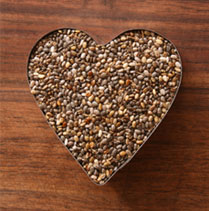
Learn what chia seeds are, their numerous health benefits, and how they can be added to a variety of kid-friendly snacks and meals!
What are Chia Seeds?
- Salvia hispanica L., more commonly known as the chia seed, is an ancient seed traditionally used in folk medicine.
- The seed was believed to have healing properties for treating eye obstructions, infections and respiratory illness.
- Chia seeds were a staple food in the Mexican diet as well as an oil source. Mexicans would roast and grind the seed to be eaten as gruel or press it for oil to be used as a body lotion and pottery polish. Today, people still soak the seeds in water or fruit juice as a refreshing drink.
Why are chia seeds healthy?
Chia seeds contain a variety of nutrients which we’ve broken down for you below.
Omega-3’s
Chia seeds can produce oil ranging from 25% to 35%, most of which is polyunsaturated fatty acids. Polyunsaturated fatty acids can be broken down into two groups, omega 3’s and omega 6’s. Chia seeds have high amounts of omega-3’s, which have been linked to lower rates of heart disease, inflammation, cancer, and nervous system disorders.
Antioxidants
Chia seeds and their oil have been found to have high levels of phenolic compounds. Phenolic compounds are found in plants and play a role in antioxidant activity. Antioxidants are important in the daily diet since they can fight against toxins that cause diseases including cancer, heart disease, and premature aging.
Fiber
Chia also holds a high fiber content. Fiber has many great health benefits, including decreasing inflammation and lowering cholesterol. It continues to be low in the typical American diet, with the average American only getting 12 grams/day (compared to the 25-30 grams/day recommended by the Academy of Nutrition and Dietetics for optimal health). Fiber slows the breakdown of foods in your body, which helps moderate the rise of blood sugar after eating a meal. There are two types of fiber, soluble and insoluble fiber, and both have their own health benefits. Soluble fiber helps bind fecal contents in your gut that can reduce cholesterol. Insoluble fiber helps you have regular bowel movements. The recommended ratio of insoluble fiber to soluble fiber is 3 to 1. Chia seeds have an even mixture of both soluble and insoluble fiber. Try these delicious overnight oats for a fiber-packed way to start the day!
Protein
These seeds are a complete plant-based protein, which means that they contain all of the essential amino acids. Our bodies can’t produce these amino acids and must get them from food sources. Only a few other plant-based foods are complete which makes chia seeds unique! Two Tablespoons gives you 4g of protein, which makes them a great addition to many plant-based meals.
Trace Vitamins and Minerals
The chia seed also offers low amounts of calcium, phosphorous and manganese. Chia seeds should not replace your calcium supplement, but they can contribute to your daily vitamin and mineral intake.
How do I eat Chia Seeds?
Chia can be a great addition to your daily diet as a functional food rich in omega-3’s, antioxidants, and fiber. The seed itself has a very mild taste and gives food an added crunch, which is why we love this cocoa chia seed pudding! Try Chia seeds in a variety of foods to see how you can incorporate this popular functional food into you and your family’s diet. It is a wonderful alternative to flaxseed, which has a strong flavor that sensitive palates may not enjoy.
Fun, tasty and easy ways to try Chia Seeds:
- Add a tablespoon to cereals, yogurt, and smoothies for a morning boost. Try this delicious breakfast smoothie with chia!
- Add a tablespoon into baking mixtures such as pancakes, waffles and muffin mix.
- Mix them into your nut butter and jam on whole-grain toast.
- Make a jelly-like mixture. Put chia seeds in a liquid mixture for over an hour, to give a texture similar to tapioca.












